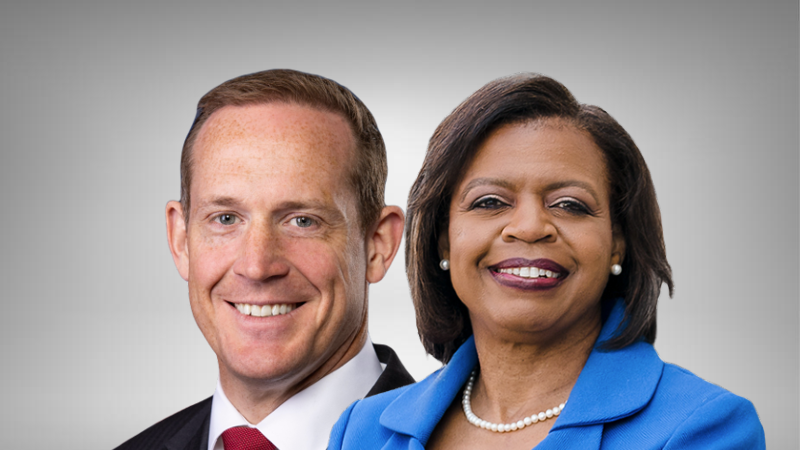
North Carolina’s contentious race for U.S. Senate may come down to the wire, but with Election Day less than a week away, Democratic candidate Cheri Beasley has trailed Republican Tedd Budd in each of the past four polls factored into Real Clear Politic’s Average, also known as the RCP Average. The most recent poll results published for the came on Oct. 20 from a Marist Poll. Among the poll’s respondents who said they are definitely voting in the 2022 midterm, Budd lead Beasley 49 – 45 percent, nearly matching his RCP average lead.
Since Budd’s lead is just outside the margin of error in most polls, North Carolina’s open senate seat may ultimately be decided by undecided independent voters.
RCP AVERAGE FOR TED BUDD VS CHERI BEASLEY
Budd currently has a 4.5 percent lead over Beasley in the RCP average. What’s more impressive is the fact that Budd led each poll taken during the month of October.
UNDECIDED VOTERS IN NORTH CAROLINA SENATE RACE:
Among all of the southeastern US, North Carolina is among three states with the highest amount of undecided voters for senate candidates.
PERCENTAGE OF NORTH CAROLINA VOTERS UNDECIDED IN BUDD VS BEASLEY SENATE RACE MOST RECENT POLLS
- 2 PERCENT UNDECIDED IN EMERSON COLLEGE POLL. Budd leads Beasley by 5 percent in the same poll, 51 to 46.
- 5 PERCENT UNDECIDED IN MARIST POLL. Budd leads Beasley by 4 percent in the same poll, 49 to 45.
- 5 PERCENT UNDECIDED IN EASTERN CAROLINA UNIVERSITY POLL. Budd leads Beasley by 6 percent in the same poll, 50 to 44.
- 13 PERCENT UNDECIDED IN WRAL TV – SURVEY USA POLL. Budd leads Beasley by 1 percent in the same poll, 43 to 42.
In North Carolina, the Republican Party has 2,222,180 registered voters, compared to 2,496,817 registered Democratic Party Voters, giving Democrats a significant lead of 274,637 voters, (or, put another way, 3.7 percent more voters)
North Carolina’s 2,635,189 voters with no party affiliation, (major or minor), account for 35 percent of the overall vote in North Carolina, making them the a larger bloc in the state.
Registered Democratic Party voters in North Carolina account for 33.7percent of all registered voters in the state.
Registered Republican Party voters in North Carolina account for 30 percent of all registered voters in the state.
The minor party with the highest percentage of registered voters in North Carolina is the Libertarian Party, with 50,154 registered voters, accounting for only 0.6 percent of all registered voters in the state. Libertarianism is based on fiscal conservatism and social liberalism, which means neither of the two major parties can count on Libertarian support in 2022, with abortion as a higher issue than past election cycles.
In North Carolina’s 2018 midterm election, 53 percent of all registered voters turned out to vote, including 55 percent of registered Democratic Party voters, 58 percent of registered Republicans, and 46 percent of unaffiliated voters voted. Earlier this week, the Charlotte Observer reported that early voting is outpacing 2018. Therefore, if voter turnout in North Carolina’s 2022 Midterm Election matches or beats the 2018 turnout figures, here’s what we can expect for 2022 Midterm ballot counts:
At least 1,212,186 ballots cast out of 2,635,189 voters registered as unaffiliated with any party.
At least 1,288,864 ballots cast out of 2,222,180 registered Republican voters.
At least 1,373,249 ballots cast out of 2,496,817 registered Democratic voters.
Despite three percent lower party participation in voting, Democrats still have a built-in advantage of 84,385 voters in this scenario.
If Republicans win 53% percent of 1,212,187 unaffiliated votes cast, that would give them 654,580 votes to 569,727 for Democrats, for a Republican net gain of 84, 853 votes, cancelling out the Democrats’ advantage of 84,385 more registered voters than registered Republicans.
Polls leading up to the 2022 Midterm election indicate much higher enthusiasm among Republican voters, so it’s safe to assume that Republicans will maintain a three percent edge over Democrats for overall turnout. With that conservative assumption (no pun intended) of a 3 percent higher Republican turnout in 2022, that would leave Democrats with only a 0.7% lead in turnout against Republicans and put the Senate in control of unaffiliated voters.

